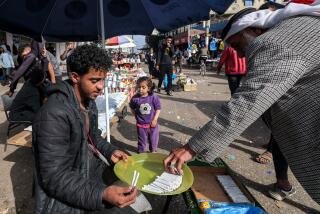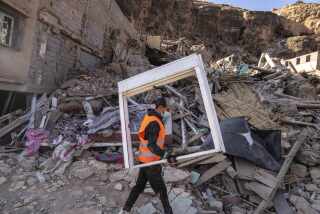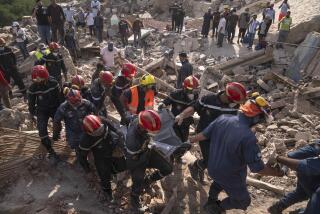Bargains Off Moroccoâs Beaten Path
GOULIMINE, Morocco â It bears a passing resemblance to a Bozeman, Mont., stock sale: farmers knowledgeably assessing the livestock, poking flanks, studying the staple of the wool, chatting quietly over the merits of the season.
But this is the weekly camel sale at Goulimine, âthe door of the desert,â a sandy, dusty, brown-bare town on the edge of the Sahara in southern Morocco. Other similarities with Americaâs rural Midwest are few indeed.
Clusters of camels, single-humped and furry-fawn, fidget huge cleft feet around the edge of the stone-walled market yard. Before them are paraded placid little posses of coarse-wooled sheep and dirty brown goats, hobbled by their front legs or with necks tied loosely together with twine.
Beside each group of a dozen or so of the smaller animals squat and stand their owners, some in flowing hooded cloaks, others in grubby once-white robes with heavy belts and jeweled, curved knives at their waists. Prospective buyers stroll through the throng, greeting one another and the sellers with the traditional Islamic handshake and touch to the heart.
Amicable Bargaining
No auctioneer shouts the odds or drums up customers. Buying and selling is a matter of amicable agreement between the parties, some of whom occasionally lead off knots of animals to waiting pickup trucks or simply drive them off across the dusty plain.
The camels, at least 40 at this Saturday sale, are sold in ones and twos rather than in herds. The going price for a good one, we are told in passable English by one of the many locals infuriatingly enthusiastic to be our guides, is about 10,000 dirhams, or about $1,200 U.S. To the people of the Sahara, the camel is transportation, food, clothing and fuel.
Most of the haughty beasts have been brought in from the desert, plodding their way in convoy from distant oases to the east or from Mauritania to the south. Here at Goulimine is the last of a chain of oases that sustain the Rijel Zurag, or âblue menâ of the Sahara, named for the indigo-dyed robes they sometimes wear.
They come not just to sell camels, but also to exchange handcrafted jewelry and prized family possessions for grain and other necessities made scarce by the prolonged drought in the Sahara. Their journeys can be long and difficult, some coming from as far as Timbuktu in the southeast, 30 days and more away.
The men travel lightly, leaving wives and children behind, sleeping by day and riding by night when the stars and rudimentary handmade compasses passed down from generation to generation define the route.
Arriving at places such as Goulimine, 125 miles southeast of coastal Agadir, and Tiznit, 70 miles closer, one or two of the blue men set up huge desert tents and offer their wares for sale. Most buyers are Moroccans; tourists are rare, especially at Goulimine, which is well off the usual tourist track.
The offerings are exotic and exciting to Western eyes: antique Berber brooches and pins, heavy bracelets of silver and ebony, jewel boxes encrusted with turquoise and amethyst, ornate silver and copper trays, triangular fibulas set with semiprecious stones, swords and daggers with scabbards chased with silver and embellished with multicolored crystals.
Ritual of the Deal
For those fortunate enough to find such a tent, the ritual of appraising the merchandise begins with a lengthy introduction between local guide, self-appointed and unshakable, and seller. Translations are lengthy before the greeting is extended--busses to each cheek twice and a gracious âmarhaba, marhaba â (welcome, welcome).
The ceremony of taking mint tea, tiny glass after tiny glass, must be completed and small talk politely exchanged before the man of the desert will open his decorated chests and pour out his goods.
Pressure to buy is subtle but pervasive. One comes to believe that to leave without buying would be an affront to the hospitality offered. The wily seller plays on this. When we eventually left, we were lighter in the pocketbook and with a somewhat bemused feeling of âI wonder if we really wanted that and did we pay too much.â
Later, a Western jewelry shop confirmed that, even though we had haggled the prices down only slightly, we had not been fleeced. Indeed, we had made considerable bargains.
Buying in the souks, or markets, of Moroccan villages frequented by tourists is a different affair. There a sharp sense of bargaining is needed to combat the outlandish asking prices. Once a hard-nosed attitude is adopted and an opening bid of a quarter to a third offered, one can make good buys in pottery, leather and silver goods at roughly half the asking price.
Sights and Sounds
One also needs a good sense of direction at the crowded bazaars in such towns as Taroudannt and Tiznit. Narrow alleys of shops and stalls twist and turn in a bewildering Aladdinâs cave of color and activity. Sights and smells of fruits, spices, shoes, rugs, live chickens, doves and white rabbits clamor for attention along with workers and works in pewter, copper, silver and tin and hundreds of shopkeepers all eager to entice one in. The mind begins to reel on such a sensual shopping safari.
It takes several days for the novice haggler to adapt to this kind of shopping and one should beware of buying early during a Moroccan holiday.
Unfortunately, most Western visitors merely deposit themselves at a tourist center such as Agadir, rebuilt after a major earthquake in 1960 in the likeness of any other resort complex, and savor nothing but the lovely beach and their hotel swimming pool. By treating Morocco as just another Costa del Sol, they shortchange both themselves and Morocco.
My wife, 15-year-old son and I found far greater excitement and reward by hiring a little Renault 4 to explore the back roads of southern Morocco for four days of our weekâs stay based in Agadir.
At places such as Taroudannt, home to 55,000 people inside five circular miles of age-old, mud-brick walls, Beau Geste came alive for us. So too did Ali Baba and his band of four; the film was shot right here, with the towering High Atlas Mountains as backdrop.
And the Goulimine camel market recreated indelible scenes reminiscent of âLawrence of Arabia.â Around a corner could have been Humphrey Bogart and Lauren Bacall.
Back at Agadir, the masses of Westerners tanning their tired bodies by the pools may have seen plenty of the sun of Morocco, but little of its shine.
An old and very heavy solid ivory bracelet with silver fittings that we should have bought was offered at 700 dirham ($84 U.S.). Our jeweler at home in London said that by our description it would have been worth at least $300 U.S.
Large solid silver trays about 18 inches to 24 inches in diameter were offered at $60-$90 U.S. (London value about $250 U.S.). Again, we should have bought at the time.
We did buy an ornate charm necklace of camel sinew with hand-beaten silver, desert stones and a silver desert âcompassâ (clusters representing the night sky by which nomads guide themselves) for $25 U.S.; another of gazelle horn, silver and set with an amethyst at $30 U.S.; an antique Berber dagger with hardwood handle, set with silver and in an ornate silver scabbard for $40 U.S., and a solid-silver scrolled bracelet, $25 U.S.
Jeweler Was Amazed
We showed all of those purchases to our London jeweler and he was amazed. For instance, he valued the $25 bracelet at $150. And in the Berber tent we haggled down the prices only 15% to 20%. If we had known the value of what we were being offered we would have bought more of the silverware, ivory and gold and silver chains especially.
The rental car wasnât cheap. For four days, including insurance and with free mileage, we paid $220 U.S. at Europcar; Hertz and Budget prices were about the same. One can hire cars from smaller local firms for perhaps $150 U.S., but without the security of a major company behind you. The weekly rate at Europcar would have been $280-$300 U.S.
Eating out in Morocco is cheap and very good. Hotels booked on the spot are very cheap (say, $10 U.S. a night) and excellent, if you donât mind going without first-class facilities. There are any number of resort hotels at about $60 U.S., including breakfast.
More to Read
Sign up for Essential California
The most important California stories and recommendations in your inbox every morning.
You may occasionally receive promotional content from the Los Angeles Times.










